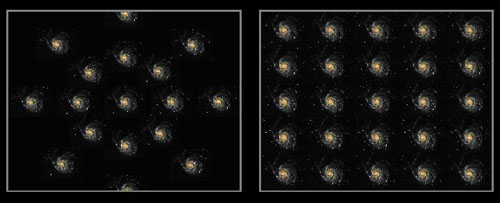Our View of the Universe
All observations that have been made using the most powerful telescopes show that the universe looks the same in all directions.
The average density of galaxies is the same throughout the universe and does not change with distance or direction. This is called the Cosmological Principle.
On average and at large scales, the distribution of galaxies is the same throughout the universe.
Since the expansion of space occurs evenly at every point in the universe, galaxies are separating from each other at about the same pace, giving the universe a nearly uniform density and structure. As a result, the universe appears smooth at large distance scales. In scientific terms, it is said to be homogeneous and isotropic.

In the image on the left, the universe is isotropic. This means that if you stand at the center and look in every direction, the universe will look the same.
In the image on the right, the universe is homogeneous. This means that if you stand in any place and look around, the universe will be the same.
Homogeneous and Isotropic: What's the Difference?
-
Homogeneous (usually pronounced homo-GEE-nee-us) literally means "to be the same throughout," no matter where you are in the universe. If you look at the universe from Earth or from a galaxy a million light-years away, it will look the same.
-
Isotropic (pronounced eye-so-TRO-pic) means to appear the same in every direction or viewing angle. This approximation breaks down when viewing the night sky from Earth since our planet is located inside of the Milky Way, but if you were able to stand at any point outside of a galaxy the universe would look the same in all directions.
Scientists are careful to distinguish between these separate concepts: uniform with respect to position (homogeneous), and uniform with respect to viewing angle (isotropic). While most intuitive examples will be both homogeneous and isotropic like our universe, in theory, there can be universes which exhibit one property and not the other.
Do Galaxies Expand?
Planets, stars, and galaxies are bound together by gravity. On the short distance scales present in these systems the force of gravity is great enough to resist and stop the expansion of space. Gravity opposes the expansion of the universe on larger scales as well, but since the strength of gravity falls with the square of the distance according to the inverse square law, the force is not enough to halt the expansion. If every object expanded with space, including ourselves, we would not perceive any expansion at all.
What is the Universe expanding into?
The expansion of the universe is consistent with the Big Bang theory, but, what is the universe expanding into?
In short, nothing. Most cosmologists believe that the universe is infinite; there is nothing outside of it. Space and time only exist within the universe. So, what happens when infinity expands? It is still infinity, just a bit bigger.
Rewinding the Universe
Think of the universe today as a movie playing. We see expansion: everything moving apart from everything else.
But what happens when we rewind the movie? Everything becomes closer and closer to everything else (and the universe becomes hotter and denser) until we reach the edge of scientific understanding: the Big Bang.
We even have a picture that goes further back in time than this movie--to the infant universe known as the Cosmic Microwave Background.
 [2.3a] Cosmic Conundrums: The Expanding Universe
[2.3a] Cosmic Conundrums: The Expanding Universe


